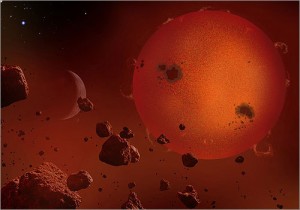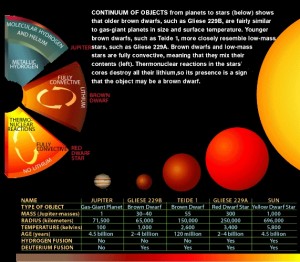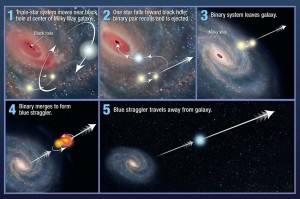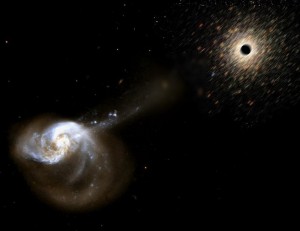The word planet means “wanderer”; the Greeks called them planētēs aster, “wandering stars”. Indeed planets travel on their orbits, wandering around their stars for millions and billions of years. Stars move along their paths in galaxies, wandering, until the end of their time. Some objects, however, do not follow this familiar pattern. These objects include planets, brown dwarfs, stars, and even black holes, bringing up the most challenging setting for a science fiction story.
Shadowy neighbors
Our Galaxy alone is full of unusual stuff. Objects known as brown dwarfs were only a theoretical concept until they were first discovered in 1995. It is now argued that there might be as many brown dwarfs as there are stars, and our closest neighbor might turn out to be an ultracool brown dwarf rather than Proxima Centauri.

These objects fall somewhere between the smallest stars and the largest planets on the heavenly spectrum, and have masses that range between twice the mass of Jupiter and the lower mass limit for nuclear reactions (0.08 solar masses). They are thought to form the same way low-mass stars do – from a collapsing cloud of gas and dust. However, as the cloud collapses, it does not form an object which is dense enough at its core to trigger and maintain hydrogen-burning nuclear fusion reactions. Their spectral characteristics are different to those of very cool stars, showing an absorption line of the short-lived element lithium. Furthermore, they have fully convective surfaces and interiors, with no chemical differentiation by depth. In young brown dwarfs, when combined with rapid rotation, their turbulent interior motion can lead to a tangled magnetic field that can heat their upper atmospheres, or coronas, to a few million degrees Celsius. Even if not fusion powered, these mysterious objects are also known to have flares.
The nuclear fusion is what fuels a star and causes it to shine, but brown dwarfs are very cool and dim compared to stars. The coolest brown dwarf yet discovered is about as hot as boiling water, with a temperature of less than 100 degrees Celsius (~ 370 K).
Update September 7th 2013: A new study shows that some brown dwarf stars may be as cool as room temperature.

The trouble with brown dwarfs is that they are hard to find. An isolated (not in a multiple system) brown dwarf is typically visible only at ages < 1 Gyr because of the rapidly fading luminosity. The lighter brown dwarfs are more sensitive to this effect. Young brown dwarfs are visible at relatively large distances but evolve rapidly, making it difficult to catch them when they are in their earliest stages of formation. Old brown dwarfs will only be visible if they are nearby. So we have more chance of discovering brown dwarfs that have just recently formed.
Dumping more mass on a brown dwarf doesn’t make it bigger, it just makes it denser. A 70-Jupiter-mass and 20-Jupiter-mass brown dwarf are both about the size of Jupiter.
From up close, a young brown dwarf would look like a low-mass star, but an old brown dwarf would look more like Jupiter.
Brown dwarfs aren’t brown, they would look red to the naked eye.
Brown dwarfs radiate most of their energy in infrared light.
Some brown dwarfs spin so fast that they complete one rotation in less than an hour.
Brown dwarfs have hydrogen cores.
The average density of a brown dwarf is about 70 grams per cubic centimeter, which is 5 times the density at the center of the Earth.
– Robert Naeye, Astronomy magazine, August 1999, p. 36-42
Brown dwarfs have also been discovered embedded in large clouds of gas and dust. Accretion discs were detected around some of these failed stars, even around those as small as 10 Jupiter masses. Astronomers discovered that some disks contain dust particles that have crystallized and are sticking together in what may be the early phases of planet assembling. A relatively large and many small grains of mineral called olivine was found; another sign of dust gathering up into planets is the flattening of brown dwarfs’ disks. But such systems will be tiny compared to our own Solar System.
Brown dwarfs emit faint visible light, but are cool enough to retain a somewhat Jupiter-consistent atmosphere. For example, Gliese 229B, discovered in 1995. Its luminosity is about one tenth of the faintest star and its spectrum has large amounts of methane and water vapor. Methane could not exist if the surface temperature were above 1200K. Astronomers consider its temperature to be about 950K (compared to Jupiter’s 130K), its mass to be between 0.02 and 0.05 of solar, and the age of the binary system to be between 2 and 4 billion years. It has a smoggy haze layer deep in its atmosphere, essentially making it, much fainter in visible light than it would otherwise be. It is possible that ultraviolet light from its companion star changes its atmospheric properties from those of an isolated brown dwarf. Theory now also suggests that young brown dwarfs are hot enough (with temperatures as high as 2000 Kelvin) to have clouds of iron and silicates. These clouds “rain out” as the brown dwarf cools and becomes dimmer. But this raining out causes a temporary brightening as obscuring clouds are cleared from the atmosphere. Considering the age and the temperature of Gliese 229b, its atmosphere should be clear of clouds, leaving it a featureless ball glowing a dull red, like a coal, from internal heat. Any moons that might had formed too close to the brown dwarf would have been torn apart by tidal forces long ago. Surviving moons, if they exist, may be heated enough by tidal forces for methane or nitrogen geysers to form.
This paper describes a collection of evolutionary models for brown dwarfs and very-low-mass stars for different atmospheric metallicities, with and without clouds.

*You should check out his website, Christian’s paintings are awesome!
Brown dwarfs are members of a group known as substellar objects. This group also includes planetary mass objects, or planemos, ranging from satellite planets and belt planets to rogue planets, to sub-brown dwarfs.
All planets are planetary mass objects by definition; their mass is expected to be greater than of minor objects (e.g. meteoroids, asteroids or minor planets) but smaller than that of brown dwarfs or stars, yet a planetary mass object (PMO) is a celestial object, which do not conform to typical expectations for a planet.
Free floating planets not orbiting a star may be rogue planets ejected from their systems (during system formation, death or some instability within its lifetime), or objects that have formed through cloud-collapse rather than accretion. Isolated PMOs with masses lower than the 13-Jupiter-mass definition of a brown dwarf, which were not ejected, but have always been free-floating and are thought to have formed in a similar way to stars, are called sub-brown dwarfs.
A rogue planet (also known as an interstellar planet, or orphan planet) is a planetary-mass object that has been ejected from its system and is no longer gravitationally bound to any star, brown dwarf or other such object, and that therefore orbits the galaxy directly. Recently, some astronomers have estimated that there may be twice as many Jupiter-sized rogue planets as there are stars. Is it getting crowded here?
If interstellar space is full of substellar objects, they might become our stepping stones for robotic (or even manned) missions in the (very) distant future. It would mean interstellar space could be reached through an “island-hopping” strategy. Even if there won’t be much of planetary systems, the resources could still be used by probes (or humans, to live in ships or whatever space habitats there might be developed).
Planets and substellar objects aside, there are even more bizarre things happening out there.
Stellar hamburgers
Blue stragglers are main sequence stars in open or globular clusters that are more luminous and bluer than stars at the main sequence turn-off point for the cluster. With masses two to three times that of the rest of the main sequence cluster stars, blue stragglers seem to be exceptions to the rule of positioning all cluster stars on a clearly defined curve set by the age of the cluster, with the positions of individual stars on that curve determined solely by their initial mass.
The explanation for this might lie in collisions and mass transfer between binary stars of the cluster. The merger of two stars would create a single more massive star, potentially with a mass larger than that of stars at the main sequence turn-off point. These blue stagglers are common residents of the galaxies. However, some blue stagglers have even more dramatic emergence.
Studies have already shown that our Galaxy is able to “eject” stars once in about every 100,000 years. And the one responsible for such deeds is none other than the black hole at the center of the Galaxy.

The incredible fate of HE 0437-539 summarized in 5 steps. 1: a triple-star system was drawn to the black hole in the center of our Galaxy. 2: one of the three stars was grabbed by the black hole and the two others ejected. 3: the duo broke away from our Galaxy. 4: on aging, the two stars merged. 5: the merger gave rise to a blue straggler which continues to move away from our Galaxy. Alone… Well, maybe not.
There will be only one…
The similar situation seems to be with another objects galaxies might like to dispose of. They indeed are very violent creatures, and during their “mating rituals” they probably can even rip out hearts.

In such hypercompact stellar systems the supermassive black hole keeps the stars moving in very tight orbits about the center of the cluster, where it resides. These objects are believed to be fairly common. In theory, hundreds of massive black holes left over from the age of galaxy formation could be lurking in the nearby universe, because they are expected to be gravitationally bound to the galaxy cluster that had produced them. So the best place for finding such objects would be regions of space dense with thousands of galaxies that have been merging for a long time, since black hole mergers within these galaxies may have resulted in violent kicks.
Update: April 2013
New computer simulations predict as many as 2000 black holes living on the outskirts of the Milky Way. Some might have been stripped bare, while others may carry a few clusters of stars and dark matter.
